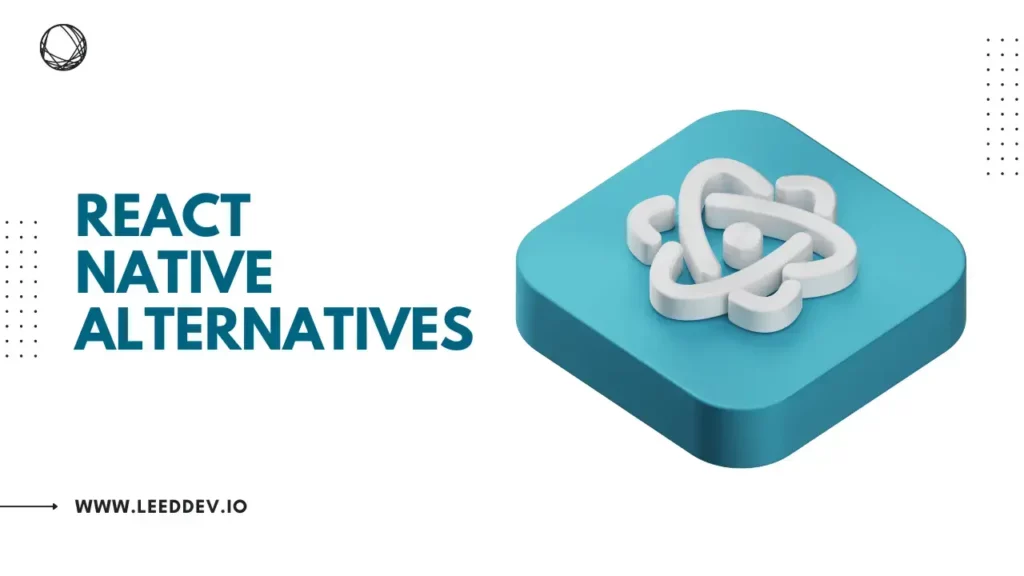React Native has been one of the most well-known frameworks for creating mobile applications. It allows designers to utilize JavaScript to create applications that run on both iOS and Android stages. However, with its popularity, there are a few reasons for why organizations and developers could search out React Native alternatives.
In this article, we’ll investigate the top React Native alternatives for creating mobile applications and examine their elements, pros, and cons. In the end, you’ll have a great knowledge of which option may be the best fit for your task.
Why Look for React Native Alternatives?
Before jumping into the alternatives to React, it’s fundamental to know the reason why you should think of them in any case. React Native is highly flexible and effective for most of tasks, however, it comes up with some limitations:
- Performance Issues: With React Native’s capacity to give near-native performance, some applications require more native performance, which can be really difficult for React Native to effectively deal with.
- Complex UI Requirements: If your application requires complex or highly customized UI parts, React Native may not regularly give the adaptability you really want.
- Native Modules: React Native depends on outsider libraries for a few native features. If the libraries are outdated or not kept up with, it can cause issues being developed.
- React Native Versions: Quick updates and changes in React Native versions can cause similarity issues or require extra improvement effort.
- Native App Feel: While Native App gives a cross-stage solution, a few developers might choose toward a more native feel that can be more effortlessly performed with alternatives.
Let’s discover some of the top react native alternatives to React Native.
Top React Native Alternatives:
Here we have listed 5 top alternatives to React Native that you need to know,
1. Flutter
Flutter, created by Google, which has gained significant momentum as a competitor to React Native. It is an open-source UI toolkit that permits developers to create natively gathered applications for mobile, web, and work areas from a single codebase.
Key Features of Flutter:
- Cross-Platform Compatibility: Flutter applications can run on both iOS and Android stages, as well as on the web and desktop.
- Native Performance: Flutter utilizes a responsive structure and the best presentation delivery to convey native-like performance.
- Hot Reload: Flutter includes a hot reload that enables designers to rapidly see the results of their code changes, speeding up the advancement procedures.
Pros:
The following are the pros of flutter:
- Quick Turn of Events: The hot-reload allows designers to see the results of their progressions immediately without restarting the application. This essentially speeds the advancement interaction, diminishing opportunity to market and application improvement costs.
- UI Consistency: UI Consistency: Flutter has a custom conveying engine, which empowers it to control every pixel. This leads to a more predictable look and feel across all stages, which a few Flutter options like Ionic and React Native battle with.
- Better Performance: Flutter applications are gathered directly to native ARM code utilizing Dart’s AOT compilation, limiting the requirement for a JavaScript bridge. Direct correspondence with the platforms leads to quicker execution and smoother animations, upgrading all performance.
Cons:
Following are the cons of flutter:
- Dart Language: Dart isn’t so well known as JavaScript, so there might be more expectations to learn and adapt for designers.
- Application Size: Flutter applications will be large as compared to React Native apps.
Flutter is one of the most practical native alternatives to React Native, particularly for projects where performance is fundamentally important.
2. Ionic
Ionic is one more famous option for creating mobile applications. An open-source system permits developers to create hybrid applications by utilizing web advancements like HTML, CSS, and JavaScript.
Key Features of Ionic:
- Web Advancements: Ionic uses standard web innovations, making it simple for web developers to change to mobile application improvement.
- UI Parts: Pre-built UI parts make it simple to create perfect and functional interfaces
rapidly.
- Native Functionality: While based on web advancements, Ionic coordinates with native functionality through Cordova or Capacitor.
Pros:
Following are the pros of Ionic,
- Availability: Web designers can easily change to mobile application advancement without learning new languages or structures. Without the expectation to learn and adapt, Ionic designers can start building extraordinary cross-stage mobile applications faster than in the past.
- Pre-designed UI parts: Ionic gives a library of pre-designed parts that keep current plan rules. These highly adjustable parts permit designers to make interesting and engaging user interfaces.
- Ionic Capacitor: This open-source, cross-stage runtime gives a bridge between web code and native functionality, enabling access to native gadget features like the camera, geolocation, and document framework.
Cons:
Following are the cons of Ionic:
- Dependency on WebView: Ionic applications run inside a WebView, which acts as a holder for the web-based code. This dependency can lead to execution issues, particularly for graphics applications or applications with complex animations.
- Native Functionality: Getting to native gadgets that frequently require modules. This makes incorporating native functionality more complex than systems like React Native, which have more direct access to native APIs.
Ionic is a great decision while you’re searching for alternatives to React that advantage of web innovations and focus on quick improvement processes.
3. NativeScript:
NativeScript is an open-source system that permits designers to create native mobile applications by using JavaScript, TypeScript, or Angular. Dissimilar to React Native, NativeScript gives direct access to native APIs without requiring a covering.
Key Features of NativeScript:
- JavaScript/TypeScript: Use JavaScript or TypeScript to create completely native applications.
- Native APIs: Direct access to native APIs without the requirement for extra libraries or modules.
- Cross-Stage: write one codebase for Android and iOS.
Pros:
Following are the pros of NativeScript:
- Hot Module Replacement: NativeScript supports Hot Module Replacement, which permits developers to see changes right away without restarting the application. This element fundamentally accelerates the improvement process.
- Native-like Performance: Developers can use native UI parts and accomplish performance near native applications. This is especially significant for applications that require concentrated calculations, complex animations, or direct collaboration with gadget equipment.
- Adaptability Around the Frameworks: NativeScript, dissimilar to React Native, supports different structures like JavaScript, TypeScript, Angular, and Vue.js. This permits developers to pick the option that best suits their project, enabling them to create excellent applications.
Cons:
Following are the cons of NativeScript:
- Learning Curve: Developers who are new to NativeScript might struggle to understand how to collaborate with native APIs and manage platform-specific nuances.
- Smaller Community: While NativeScript has a committed community, it is smaller than the mainstream systems like React Native or Flutter. This can result in less accessible resources, modules, and outsider integrations.
4. Kotlin Multiplatform Mobile (KMM) :
Kotlin Multiplatform Mobile (KMM) is a framework from JetBrains that permits you to share code among iOS and Android applications using Kotlin. KMM is certainly not a cross-platform framework like React Native or Flutter, but it permits code sharing among platforms while still creating native apps.
Key Features of KMM:
- Kotlin Language: KMM uses Kotlin, a cutting edge and well known language for Android improvement.
- Code Sharing: Designers can share business logic across stages while creating completely native UIs.
Pros:
Following are the pros of KMM:
- Bright Future: Kotlin has solid help from JetBrains and Google, which will guarantee for the continuous improvement and community
- Reduced Duplication: KMP permits developers to compose normal code that can be shared across various platforms. By sharing code, KMP eliminates excess code and reduces the risk of irregularities and bugs, leading to a more smoothed out and proficient improvement process.
- Platform-Specific Code: While KMP is heavy on code sharing, it also supports platform-specific executions. Developers can compose platform-specific code for features that require direct interaction with native APIs, for example, UI components or hardware access.
Cons:
Following are the cons of KMM:
- Learning Curve: There is a starting learning curve for designers who are new to Kotlin. However, Kotlin’s grammar and key elements are designed to be agreeable and simple to learn.
- No Hot Reload: Dissimilar to React Native and Flutter, KMP doesn’t support hot reload, which can slow the advancement procedures.
- Experimental: However KMP depends on Kotlin’s ecosystem, it is still considered experimental, which could lead to dependability issues at some times.
5. Apache Cordova:
Apache Cordova is an open-source mobile improvement framework that permits designers to make cross-platform mobile applications with mobile standard web innovations like HTML5, CSS3, and JavaScript. Initially, it is known as PhoneGap, Cordova provides a platform for designers to create applications for various stages, including iOS, Android, and Windows, using a single codebase.
Key Features of Apache Cordova:
- Cross-Platform Development: Create applications that work on various stages (iOS, Android, Windows) by utilizing a single codebase.
- Web Innovations: Uses HTML5, CSS3, and JavaScript for application advancement, making it accessible for web developers.
- Access to Native Features: Cordova gives a bunch of JavaScript APIs to access native gadget features like the camera, contacts, accelerometer, document framework, and many more.
Pros:
Following are the pros of Apache Cordova:
- Cost-Effective: Cordova permits developers to compose code once and send it across various platforms, decreasing the expense and effort needed to maintain with independent codebases for iOS, Android, and different platforms.
- Recognizable Advances: Developers with a background in web improvement (HTML, CSS, JavaScript) can easily change into mobile improvement without learning stage platform-specific languages like Swift or Java.
- Access to Gadget Features: Cordova gives APIs to access native gadget features, making it simple to execute functionalities like the camera, GPS, and pop-up messages without composing platform-specific code.
Cons:
Following are the cons of Apache Cordova:
- Performance Limitations: Since Cordova applications run inside a WebView, they may not proceed as effectively as native applications, especially in applications requiring complex animations or graphics.
- Restricted Native Experience: Cordova allows for access to native elements, the overall client experience may not feel as polished as completely native applications. This can affect client fulfillment, especially in performance-heavy apps.
- Plugin Reliance: Cordova depends on Plugin for native functionality. If the plugins are outdated or poorly maintained, it can make difficult for application performance or similarity with new operating system versions.
Summary:
React Native has been a leading structure for feature-rich application improvement. However, understanding the top react native alternatives can assist you with picking the best solution as your needs arise. The frameworks we have listed can be your top decision when in need. Make sure to pick the one that suits perfectly for your application improvement requirements.
We “Leed Software Development Company” help you speed up in business development and increase client engagement through top level React Native Alternatives applications that are cross-platform compatible. We make natively delivered web, mobile, and desktop experiences by utilizing React Native, a strong UI programming system made by Meta Platforms.
FAQs
Is there anything better than React Native Alternatives?
Flutter, Google launched Flutter in 2017, and it quickly became one of the most popular alternatives to React Native. This open-source UI software development kit allows developers to build cross-platform applications from a single codebase for mobile (both iOS and Android), web, and desktop.
Is Flutter better than React Native 2025?
Choose Flutter if your developers are familiar with the Dart programming language. If you want lower development costs, short time-to-market, and native-like performance, we recommend sticking to React Native, it’s the most popular cross-platform framework in the world.
Does Instagram use React Native Alternatives?
You can go ahead and mark React Native down as a tried and trusted framework. Not only does Facebook itself use the framework, but so does Instagram, Airbnb, and Uber Eats. There are many other React Native examples too and you’ll learn more about the companies using React Native in a moment.
Is WhatsApp built on React Native Alternatives?
Yes, WhatsApp uses React Native for its mobile application. React Native allows WhatsApp to create a single codebase that can be used to deploy its app on both iOS and Android platforms.




